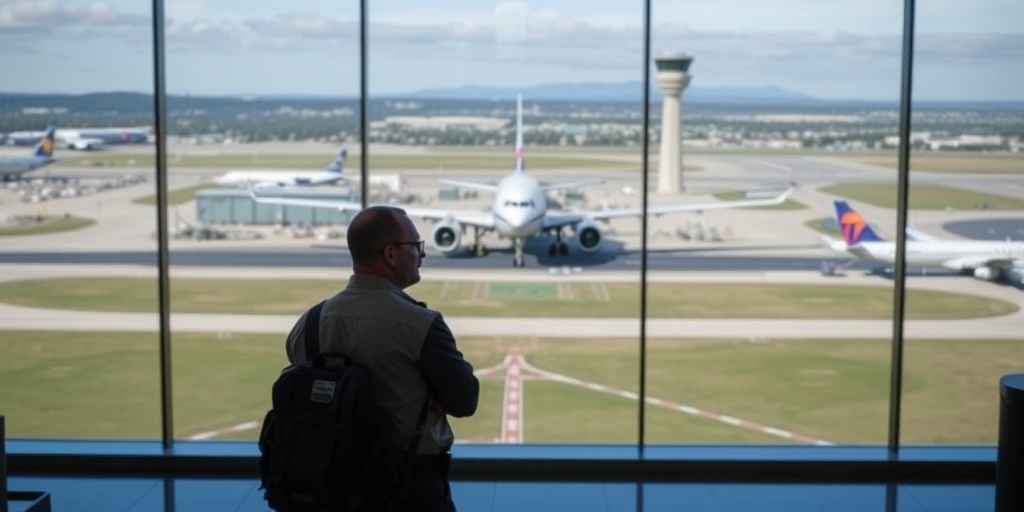Now Reading: Air Traffic Control Trainees to Receive 30% Pay Increase
-
01
Air Traffic Control Trainees to Receive 30% Pay Increase
Air Traffic Control Trainees to Receive 30% Pay Increase

Increase in Pay for Air Traffic Controller Trainees Announced to Combat Staffing Shortages
Transportation Secretary Sean Duffy recently unveiled a significant initiative aimed at addressing the ongoing challenges within the nation’s air traffic control system, highlighting the Federal Aviation Administration’s (FAA) decision to raise pay for air traffic controller trainees. During a press briefing held at the FAA Academy in Oklahoma City, Duffy announced that trainees’ hourly wages would increase by $5, elevating their pay from $17.61 to $22.84 an hour. This increase is part of a broader effort to enhance recruitment and retention within the agency. Duffy emphasized that the raise is expected to take effect within the next month, signaling a proactive adjustment to meet the growing demands of the aviation sector.
In his remarks, Duffy acknowledged the rising costs of living, which have made it increasingly challenging for trainees to support themselves while undergoing rigorous training to become air traffic controllers. "Cost of living has gone up," he noted, underlining the necessity for a wage that allows these aspiring professionals to sustain themselves during their training period.
The announcement comes at a crucial time, as more than 90 percent of the country’s air traffic control facilities are currently short-staffed, creating a significant strain on the aviation safety system. Duffy made it clear that the funds required for the pay increase were already available through the agency’s budget and would not necessitate an additional request to Congress, easing concerns about the financial implications of these changes.
In addition to the pay raise, Duffy outlined plans to streamline the hiring process for qualified candidates, particularly those who excel in their applications to the academy. He expressed a commitment to fast-tracking high-scoring applicants to ensure that the FAA retains top talent while they await available positions. This strategy aims to mitigate the inefficiencies currently plaguing the FAA’s hiring practices, which Duffy described as “inefficient and slow.”
During his visit to the academy, Duffy engaged directly with trainees, discussing the numerous challenges they face in their roles and gaining firsthand insights into their training experience. Training and staffing are vital components of improving air traffic control efficiency and safety, and the secretary’s focus on these areas reflects an urgent need to address existing gaps.
Moreover, Duffy addressed the urgency of upgrading outdated technology utilized within the FAA. He noted that some of the agency’s systems, including rotary phones, had become burdensome and costly to maintain, as parts are increasingly difficult to procure. “It was cheap technology at one point, but today, it’s expensive because you don’t have parts,” he explained. “You don’t have people who know how to fix a rotary phone, because it’s so old.” This commentary underscores the need for significant technological advancements alongside efforts to bolster staffing levels.
Challenges associated with the air traffic control system are not new. They have been exacerbated under the current administration, particularly following a series of high-profile accidents and near misses, including a tragic incident on January 29, when an American Airlines regional jet collided with an Army Black Hawk helicopter over the Potomac River, resulting in the deaths of 67 individuals. This event marked the deadliest U.S. commercial plane crash in over a decade and heightened calls for urgent reform within the FAA.
In recent years, the FAA has also faced workforce reductions linked to broader governmental restructuring. Although air traffic controllers and aviation safety inspectors were exempt from these cuts, union representatives have highlighted that critical support staff were let go, further compounding the staffing crisis within the FAA.
Amid these challenges, Duffy reaffirmed his commitment to ensuring the agency continues to hire air traffic controllers, stressing the importance of safety in the aviation industry. “I don’t want to see people lose their lives because we have an air traffic control system that fails, and time is of the essence,” he stated, highlighting the urgency of addressing staffing and technological gaps in the current system.
The initiatives announced by Secretary Duffy mark a critical step toward revitalizing the FAA, addressing long-standing issues that have remained unresolved for far too long. By enhancing pay, streamlining the hiring process, and upgrading outdated technology, the agency is taking necessary measures to ensure a safer and more efficient air traffic control system for the future. As the aviation industry continues to evolve, these strategies could prove essential in safeguarding the airways and supporting the dedicated professionals who navigate them.
Stay Informed With the Latest & Most Important News
Previous Post
Next Post
-
 01New technology breakthrough has everyone talking right now
01New technology breakthrough has everyone talking right now -
 02Unbelievable life hack everyone needs to try today
02Unbelievable life hack everyone needs to try today -
 03Fascinating discovery found buried deep beneath the ocean
03Fascinating discovery found buried deep beneath the ocean -
 04Man invents genius device that solves everyday problems
04Man invents genius device that solves everyday problems -
 05Shocking discovery that changes what we know forever
05Shocking discovery that changes what we know forever -
 06Internet goes wild over celebrity’s unexpected fashion choice
06Internet goes wild over celebrity’s unexpected fashion choice -
 07Rare animal sighting stuns scientists and wildlife lovers
07Rare animal sighting stuns scientists and wildlife lovers





















